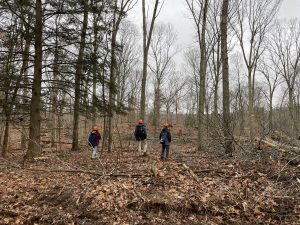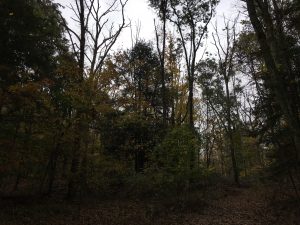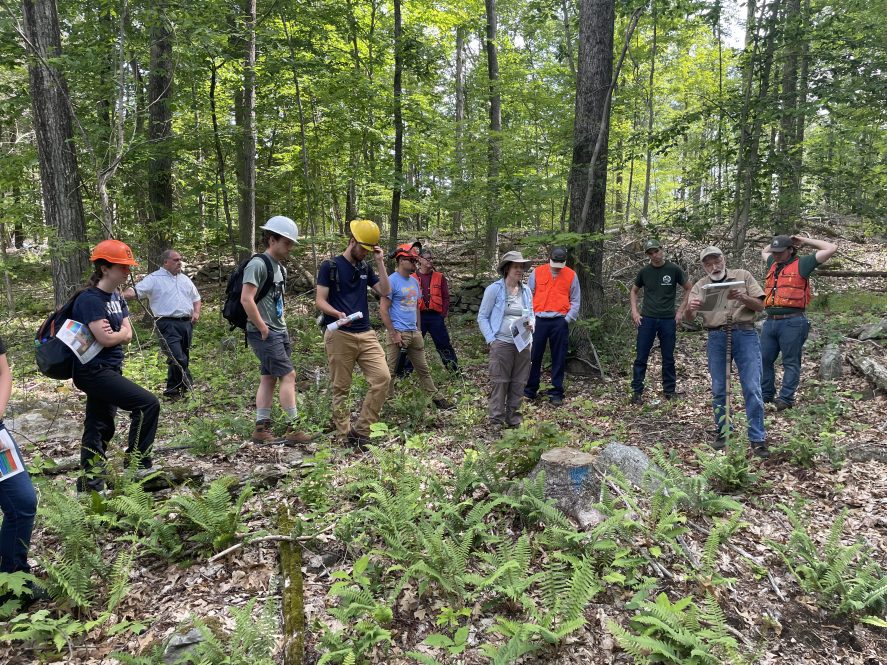The sounds of chainsaws and woodchippers and the sights of stands of dead trees have become more familiar in recent years across Connecticut. Forests are under stress and are being lost – an average of 13 acres of forests lost per day since 1985 – prompting an urgent question: what does the future of Connecticut’s forests look like?
A team of UConn researchers including Department of Natural Resources and the Environment Associate Professor of Applied Forest Ecology and Director of the UConn Forest Robert Fahey, and Associate Extension Professor Tom Worthley are trying to help give our woodlands a fighting chance by developing strategies to build resilience in the face of the intersecting challenges trees face in our changing climate.
Forest management, or silviculture, is described as both an art and a science, requiring one to consider many factors and moving parts to achieve a desirable outcome. The outcomes could be sustainable timber production, habitat restoration for wildlife, or preserving forests for the innumerable benefits they provide for the whole ecosystem.
Worthley explains how a group of researchers published a paper to promote “Adaptive Silviculture for Climate Change” (ASCC) and develop a nationwide research network in which they proposed different silvicultural approaches to improve the health, diversity, and productivity of forests as the climate changes. The resulting national ASCC project fosters collaboration between foresters, scientists, and other stakeholders, encouraging regional project teams to design treatments relevant to different regions and to develop site-specific solutions.
Fahey and Worthley are applying similar methods to New England forests with the Southern New England Exurban Affiliate Oak project, which is implemented on sites in Eastern Connecticut and Western Rhode Island.

Anticipated climatic changes are many, explains Worthley. These include meteorological shifts away from what trees have evolved to thrive in, including conditions such as wild temperature swings in the wintertime to periods of extended drought followed by intense rain, to more frequent and stronger storms. These variable conditions are pushing many species of tree to their limits.
Fahey adds that the arrival of invasive species like the emerald ash borer and the spongy moth add to the challenges trees face, in addition to development pressures that reduce overall forest cover and fragment the landscape.
“There are all these disturbance interactions layered upon each other and the trees are having to deal with it all at once,” Fahey says. “That leads to novel conditions and mortality events like the spongy moth outbreak, which was also layered on top of one of the most intense droughts in the last 100 years. We think that interaction is what led to the high levels of mortality.”
Climate adaptation experts have promoted the adoption of three potential silvicultural approaches to adapting forests to changing climate: resistance, resilience, and transition.
A resistance treatment aims to maintain the status quo in species mix and age structure, says Worthley, to essentially promote health and growth of what is already present. Southern New England forests are largely dominated by oak and hickory canopies with subcanopies of more shade-tolerant hardwoods. This approach seeks to maintain this mix and is being tested along with the other strategies at the UConn and Mohegan State Forest research sites.
A resilience treatment attempts to create age class diversity within the stands, says Worthley. With this approach, managers try to achieve a mix of some old trees and some young trees and some in-between trees and to try to give some competitive advantage to new oak and hickory seedlings that will form future generations of our forests.
Transition treatments encourage a suite of species that are likely to have an advantage in future climates. Growing zones are and will continue to shift, changing the range of different species. Researchers note species that are native to Connecticut but tend to be found in the southern part of the state, then they see what they can do to encourage some of those species to grow in more northern locations. For instance, where oaks and ashes have succumbed and site conditions are appropriate, we can replant or encourage tulip poplar, a species that has traditionally been more frequently found in southern Connecticut but is now making its way further north.
“One of the interesting twists on our transition treatment sites is the reintroduction of hybrid American Chestnut because it’s a traditional species that was always here,” says Worthley. “It’s a species that is not particularly tolerant of shade so is well suited to grow in the openings that have been created by the loss of oak trees from the spongy moth.” A hundred years ago, American chestnuts that had been dominant members of the forest canopy were being lost to the chestnut blight.
Connecticut’s landscape is unique, with non-contiguous, fragmented stretches of forest. The other national ASCC research areas are around 400-500 acres – much larger than what could be tried in exurban Southern New England. As a result, the plots installed in Mohegan State Forest in the town of Scotland and the Lee Farm Tract in the UConn Forest mimic the parceled and fragmented forest conditions found across the state, says Worthley.
Fahey says the overall development of management prescriptions uses an approach often called co-development, a process that brings together scientists, practitioners, and other stakeholders to create future-focused management plans together.
“This is partly a site-level and regionally focused project where treatments and implementation are meant as a demonstration that can then be used to do research, but also as a demonstration that can show some practices that can be used broadly across the region and adopted as we’re trying to promote climate adaptation in the region,” Fahey says.
The team is working with collaborators from the University of Rhode Island, where they have a parallel installation of treatments and have done a co-development process with slightly different treatments for the context of Rhode Island, which was hit even harder by the spongy moth, says Fahey.
“We’re also planning to implement another replicate of the project at the Lee Farm Tract of the UConn Forest, which we use for research and outreach around forest management and specifically, will be used as a demonstration to promote this idea of climate adaptation and forests.”

This has meant engaging students with hands-on experiences, with undergraduates working as research technicians and on the UConn Forest Crew, which has been very rewarding for the team. Amanda Bunce, a Ph.D. student in Fahey’s lab, is researching social science aspects of engaging with stakeholders as they develop forest management prescriptions.
Fahey says there has been much interest in this work at the state level and beyond. The team led a field tour in June attended by DEEP Commissioner Katie Dykes, Deputy Commissioner Mason Trumble, Director of the Office of Climate Planning Rebecca French, and State Forester Christopher Martin. As part of the Governor’s Council on Climate Change and the Forest and Working Lands working group, Fahey sees growing support in trying to understand how to apply climate adaptation in our forests more broadly.
“This is a good starting point to bring to the state which must involve, not just state lands, but also private landowners,” he says. “We’re hoping this work can show people that active management in forests can promote climate adaptation and climate resiliency if it’s done right. We can use this to encourage active participation in understanding and using forests across the state rather than just turning them all into new housing developments. If people see the value of forests as a climate mitigation tool, we can actively promote climate adaptation and that’s to the benefit of maintaining forests for the future.”
Worthley notes that forests are seen as one of the solutions for climate change because trees sequester and store carbon; but to do that, a forest needs to be healthy, productive, and resilient.
“The problem is that nature just isn’t natural anymore because of the unanticipated consequences of the actions of human beings in the landscape,” Worthley says. “We have air pollution, water pollution, deer over-abundance, absence of fire, non-native invasive plants and invasive insects and the solutions to these problems require intervention or management to keep the forest healthy and productive. These are the issues we are seeking solutions for. We need to be able to have strategies to offer various owners, whether it’s land trusts, the state, or private landowners. We hope to be able to offer ideas to help them manage the stresses that are anticipated with a changing climate, so they can continue to enjoy the benefits, rewards and satisfactions that come with being good land stewards. That’s what the experiments are all about.”



